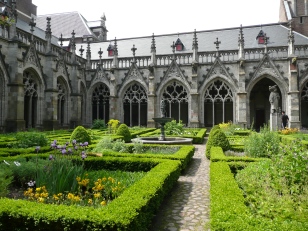By Elizabeth Smislova

The Met Cloisters feature several gardens modeled after those in medieval European monasteries, exuding peace. (Courtesy of Flickr).
As a Washington, D.C. native, I adored the multitude of free and incredible Smithsonian museums on the National Mall. Throughout my life, I have turned to them as a refuge from a hectic life and reminder of the unimaginable history of and beauty in the world. However, the National Gallery of Art has always been my favorite — I know it like the back of my hand. I thought the Metropolitan Museum of Art on Fifth Ave. or the Museum of Modern Art would take on that role of sanctuary in a busy city as the National Gallery did, but to no avail. I found my haven where some of the city’s best gems are hidden: way uptown.
The Met Cloisters definitely embody the meaning of their name, as they are as secluded as a museum could be in such an otherwise extremely crowded city. They are hidden within Fort Tyron Park in Upper Manhattan, which is one of the most beautiful places I have been to.
The park is on a ridge that overlooks the Hudson River, and is covered in beautiful flowers and greenery. The walk to the Cloisters through the park is long and winding, but the views are well worth it — especially in the fall. Fort Tyron Park also has a special history, as it was created by John D. Rockefeller Jr. in the early 1900s (he also bought a collection of Medieval art that spurned the building of the Cloisters).
The art collection at the Cloisters is mostly from Medieval Europe. The architecture of the museum itself is my personal favorite because it was designed to kindle the feeling of monastic life in medieval cloisters. There are outdoor gardens, enclosed gardens and indoor chapels that all make the bustling urbanism die away, leaving you with just peace and art. During the warmer months, there is even a café in one of the outdoor gardens with a gorgeous view of the river. Much of the Medieval art is religious, so with the added monastery feel of the Cloisters, the museum can take on a faith-related role as well.
There are rooms filled with ornate and aesthetically pleasing religious artifacts from thousands of years ago, like crosses, bibles, altars and paintings. This devout element is only there if the visitor wishes it to be, but there is something staggering in knowing the beliefs of so long ago are still prospering. It inspires hope that humanity as a whole can salvage good from any conflict or hardship.
Amongst the 2,000 works of art and several gardens, there are a few specifics that are a must-see. The famous Unicorn Tapestries from the late 13th century in the Netherlands are a prize in the collection. The one called “Unicorn in Captivity” is especially well-known, and for good reason. The tapestry is so intricate and alluring; it is incredible that it has maintained so much of its beauty for so long.
One you cannot miss is the Apse from San Martín at Fuentidueña, which is a chapel from 12th century Segovia, Spain. The piece is huge, but it is mostly its age that makes the viewer feel small. The Cloisters truly evoke the feeling of being in Medieval Europe through their astounding preservation and presentation of ancient art, specifically art that is large and intended for more daily use than paintings, like chapels.
Admission to the Met Cloisters is by donation, so while they suggest students pay $12, you can offer whatever you can. To get there by subway, take the D or B train to 145th St. and take the A train up to 190th St. From there, walk through Fort Tyron Park, following the signs for the Cloisters. The most direct route is taking the Bx12 bus from E Fordham Rd. to the Broadway/Isham stop. The Met Cloisters is open every day from 10 a.m to 4:45 p.m.
